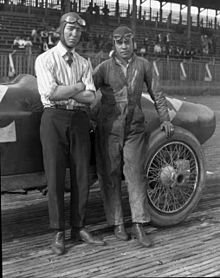Riding mechanic
The various duties included manually pumping oil and fuel, checking tire wear, observing gauges, and even massaging the driver's hands.
In the first 500, driver Ray Harroun notably drove solo, the only car in the field without a riding mechanic.
[3] Starting in 1912, the AAA Contest Board declared that riding mechanics were mandatory for all races of 100 miles or longer (which included Indianapolis).
[4] The mechanics sat in a passenger seat, typically to the outside of the driver, a precarious position close to the retaining wall.
[6] While accurate records are incomplete and spotty overall, the identification of riding mechanics from the history of the Indianapolis 500 is mostly complete and fairly reliable.


